Musicarta Modes - Aeolian Seven
The Aeolian Chord Family (Part 2)
This module adds iv (‘Four minor’) to the current Aeolian set – D minor in our A Aeolian key.
Download up-to-date MIDI files for this page.
Get to know the module riff.
Here is the first part of the module riff, discussed below
Finding the new chord
The D minor chord only appears in second inversion in this riff (square inversion symbol). Here is a recap of how you find any second inversion chord from its root position mother chord. (Read through even if you already know, for revision.)
Look at how the D minor right hand chord is written in the module riff MS. (These are the four chords you hear repeated at the start of the riff.)
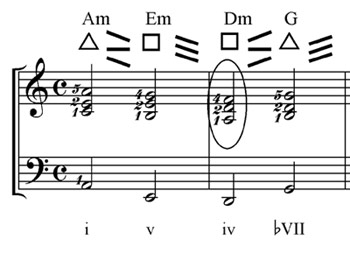
- The top two notes are closest together. The bottom note is the note furthest away. Read from the bottom up, this is a P M M P M P chord.
- The two close-together notes are always from the simple root position P M P M P chord. The top note of the root position chord has dropped down an octave to make the second inversion chord.
- Find a root position D minor chord – P M P M P, built on D. We are working in A Aeolian, an all-white-key mode, so you can safely just count off the white keys starting on D to find it. See it in your mind’s eye, or work it out at the keyboard.
- Drop the top note (A) down an octave. You have your second inversion, square symbol, D minor chord. The root (name-note, D) is the middle note of a P M M P M P (second inversion) chord.
- Unless you see a ‘slash chord’ chord symbol, you can take it for granted that the left hand will be playing the root (D).
Work through all the opportunities presented
to practice inverting triads. ‘Seeing’ the next inversion up or down of a chord
makes playing interesting music much easier.
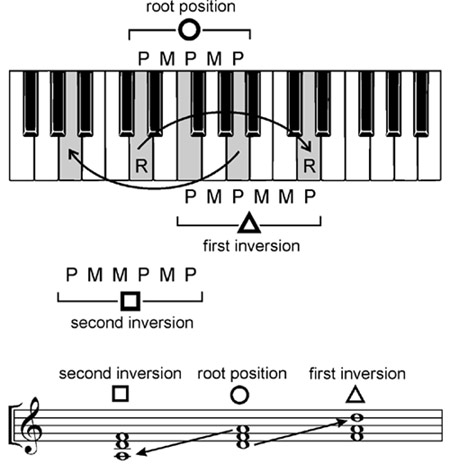
The module riff chords
Here are the skeleton chords for this module’s riff.
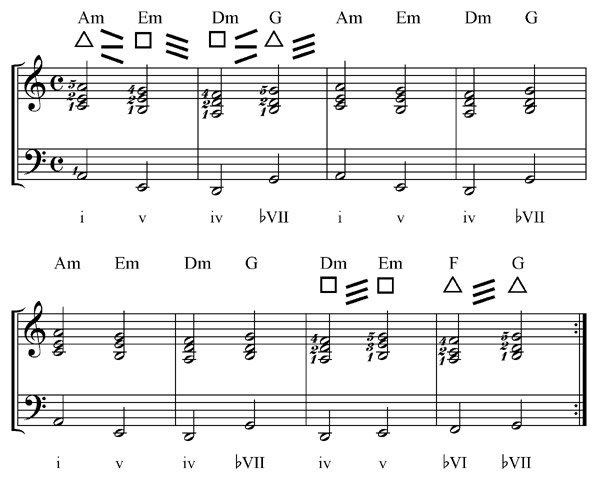
Use the voice movement diagrams to help you learn the chords. Voice movement diagrams simply show on paper what the proficient pop musicians is thinking: “The middle note stays the same, the two outside notes drop down…. everything goes down, perfectly parallel … “, etc. You should be thinking that way too.
Now we add some rhythm. Here is the pattern of the first six bars.
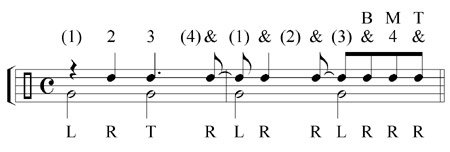
This is the rhythm for the first six (3 x 2) bars. The D minor and G chords are dragged forward (anticipated). The BMT refers to the bottom, middle, top of the G chord.
If you have found your chords correctly, you should be able to play along with the audio for the six bars – perhaps a little more slowly.
Here’s the audio again, for convenience.
The last pair of bars has more syncopation:

Listen to this repeating audio/MIDI as you look at the beat map above. Work at it until you see what right hand notes to fill the pattern with and play the section.
That completes the first chorus of the module audio. In the second chorus, the bass part drops the plain minim rhythm and picks up the beat. The rhythms are all familiar from earlier modules in the series./ Listen to the audio carefully, tap along, then ‘tap’ the chords and broken-chord chord tones at the keyboard in the rhythmic patterns you’ve identified. Expect to put in some hours getting a performance like this together!
A slow variation
Any chord sequence can be ‘realised’ (played) in an infinite number of ways. Here is a slower realisation of the riff chord sequence in six-eight.
This realisation uses two left hand accompaniment patterns. We used them before, in Module Nine. Recall how the two patterns are made out of the three chord tones of the root position triad.
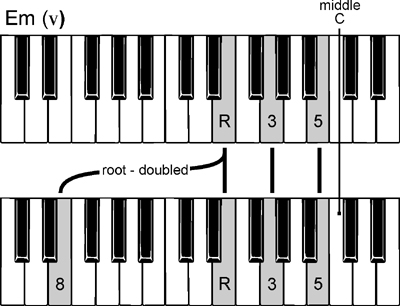 Type One: R 5 8 10 |
 Type Two : 8 R 3 5 |
We use two different patterns because the R 5 8 10 pattern down in E minor/D minor sounds too low.
In addition to the two patterns shown, we also need, for the accompaniment,
- A Type One G major pattern – the same shape as the A minor pattern but one key to the left.
- Another Type One pattern in F major, one key again to the left.
- A Type Two D minor pattern – the same shape as the E minor pattern but shifted one key to the left.
Find these accompaniment patterns. Here is a left-hand-only practice section to guide your practicing.
Here is the MS for this slow variation. Study it as you listen to the audio again to see how it matches up. Read the notes about the patterns written on the MS. They are all useful things to know about this piece, and creative ways to think about playing popular music.
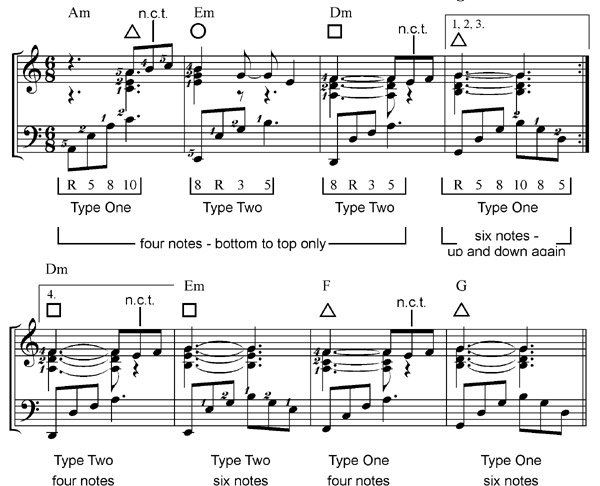
As usual, the melody is made up of chord tones on the beat with smoothing-out non-chord tones in between.
The full module riff
The full module riff puts together the two sections you have learnt and finishes off by revisiting the faster first section material. Listen to the final section on its own (below) and build your performance from the audio clip and the following notes.
The ‘reprise’ (this final section) starts with both hands playing in the syncopated rhythm of the top line of the first beat map, with the left hand playing its chords an octave higher to keep the sound quite small.

Then the left hand drops and you play a fully syncopated chorus, and to signal that the ending is approaching, you repeat the last four chords (D minor, E minor, F and G) twice, finishing with some strong A minor chords
Train yourself to listen out for the structural
features of songs and instrumental pop pieces like these. Knowing a piece’s
structure makes it easier to play – and remember. Learning about song form
makes it easier to write songs or compose – you’re not starting from scratch,
you’re filling a ready-made pattern with your own material.
|
OUT NOW! |
THE MUSICARTA BEAT & RHYTHM WORKBOOK At last! An effective approach to keyboard rhythm & syncopation skills. Learn more! |
ONLY $24.95! |
MODES |
The MusicartaA methodical approach to keyboard syncopation for
|
PUBLICATIONS
exciting keyboard
creativity courses
CHORDS 101
WORKBOOK

~HANON~
video course

Musicarta
Patreon
PENTATONICS
WORKBOOK
video course

Creative Keyboard
video course

BEAT AND RHYTHM
WORKBOOK

- Volume 1 -

12-BAR PIANO
STYLES WORKBOOK

MUSICARTA MODES
WORKBOOK

PIANO STYLE

CANON PROJECT
video course

VARIATIONS
video course


- Piano Solo -
video course

- Piano Solo -


YouTube playlists





 THE LOGO
THE LOGO
